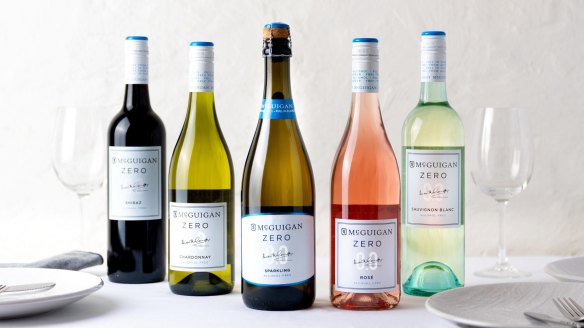Booze-free showdown: non-alcoholic wines put to the taste test

One of the fastest growing drinks categories isn't canned prosecco or bone-dry rosé, it's non-alcoholic wine and its rise is only just beginning.
According to data from market research company IRI, the non-alcoholic wine category is now worth $1.1 million domestically on the back of 800 per cent growth in the 12 months leading up to May.
"Mind you, that growth has come from a fairly small base," says Paul Madden, who founded Geelong-based online store NonAlcWines in 2006.
"But certainly, the range has increased dramatically and the quality is improving, particularly with more Australian winemakers looking to create products for health-conscious consumers."
People may also buy non-alcoholic wines because of pregnancy, religious reasons, or for practical purposes such as driving a vehicle, says Madden.
"Sales have increased even more since the coronavirus hit. I think people like to have a drink at the same time they're working from home."
In response to the trend, industry giant Australian Vintage expanded its portfolio this year to include a zero-alcohol range by McGuigan Wines, featuring shiraz, rosé, chardonnay, sauvignon blanc and a sparkling.
"Our winemaking team have been focused on crafting zero-alcohol wines that deliver the most varietal character possible," says Australian Vintage marketing director Scott Burton.
"That's the primary challenge with alcohol-removed wines – ensuring the flavour profile is as close to 'regular' wine as possible."
Can non-alcoholic wine ever stack up to regular wine though? The Sydney Morning Herald and The Age tasted six brands available from major retailers to find out.
Maggie Beer Sparkling Chardonnay, South Australia, $12
3/5
Non-alcoholic wine is often produced using methods such as cold filtration to remove booze from a fermented beverage. However, some varieties, such as this fizzy number from Australia's favourite pheasant farmer, are a simple mix of carbonated water and grape juice. With honey and sherbet on the nose, the aroma is more Passion Pop than chardonnay, while in the mouth it's all tropical fruit. Inoffensive stuff, really, but also too sweet to pair with freshly shucked oysters as Mags recommends. Lime cordial vibes on the finish suggest this would be top mates with ice and a lug of ginger beer.
Blue Nun White, Germany, $12
No stars
Missing, presumed extinct, Blue Nun is back. Sadly, there is nothing to recommend about this alcohol-free version of the lost party favourite, unless sulphurous rotten-egg aromas are your jam. Crikey, there is some acid too. When buying de-alcoholised wine, consider avoiding brands where acid features on the ingredients list rather than occurring naturally in the taste profile. Otherwise, a degree of harshness can be expected, similar to Blue Nun with its ascorbic acid additive here. What grape is it? Great question. The label provides no further detail except "white", while the Nun's website only specifies "German grapes". Avoid.
Ara Zero Sauvignon Blanc, Marlborough, New Zealand, $20
2/5
Grassy tinned pea and asparagus odours? Yes, it's sauvignon blanc in all its methoxypyrazine-heavy glory. This just tastes like really, really, flat savvy with no complexity on the midpalate. Mercifully, the acid is subdued so it doesn't drink like you're licking a battery. There are a lot better sauv blancs on the market, absolutely, however it's not hard to find worse Marlborough plonk at the same price point either. With 43 kilojoules per serving, Ara has the lowest energy content on this list. (A glass of standard wine contains around 450 kilojoules.)
Edenvale Shiraz, South-Eastern Australia, $9.50
2.5/5
Also known as "that fake wine they sell at Coles and Woolies". Established in 2006, Edenvale is Australia's most widely available alcohol-removed wine brand. Its light-ish shiraz has fresh plum and tinned pear on the nose, but the overall drinking experience is underwhelming. Alcohol is vital for adding body to wine – for lifting aromas and lacing flavours and giving cause for excitement. Its absence seems to be more noticeable in reds, thus creating a confusing sensation for the regular wine drinker. A bit like walking up an escalator that isn't moving.
McGuigan Zero Shiraz, New South Wales, $12
3/5
"Best served chilled" according to McGuigan Wines, a recommendation rarely seen on a shiraz label but here we are. Gee whiz, there is a lot of oak happening on the nose, with only a hint of red currant in the background. (It's unlikely many wineries would be keen to waste an oak barrel aging non-alcoholic wine, and McGuigan confirms it does use oak alternatives for this release.) The acid is balanced in any case and stewed cherry on the finish makes this a decent pairing for red meat if booze isn't an option. Some tannins would be nice though.
Domaine de la Prade Premium Organic Merlot-Shiraz, France, $34
3.5/5
Shop around and you can find this French drop for $25, but that still seems expensive considering alcohol-free wines are classed as food products, and therefore exempt from the same tax regulations as standard wine. The high cost of organic farming may be a factor. Price aside, this is the pick of the booze-free bunch, with balanced oak and acid, aromas of stewed fruit, and toffee on the palate. Like all alcohol-free wines tasted, it still has a slight flavour of damp cardboard, but overall the blend is a step in the right direction. Watch this space.
